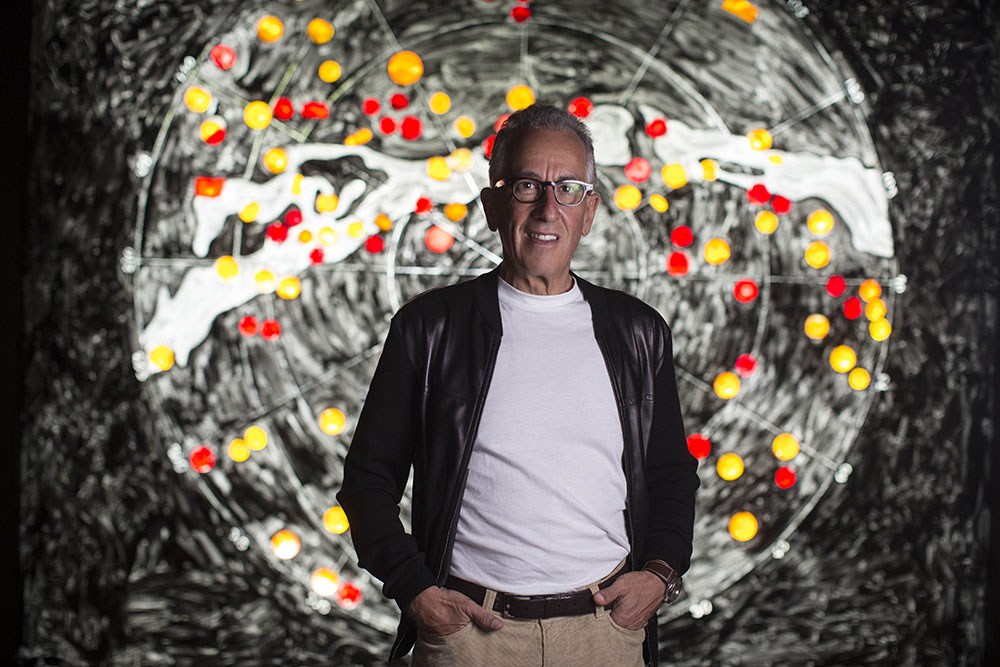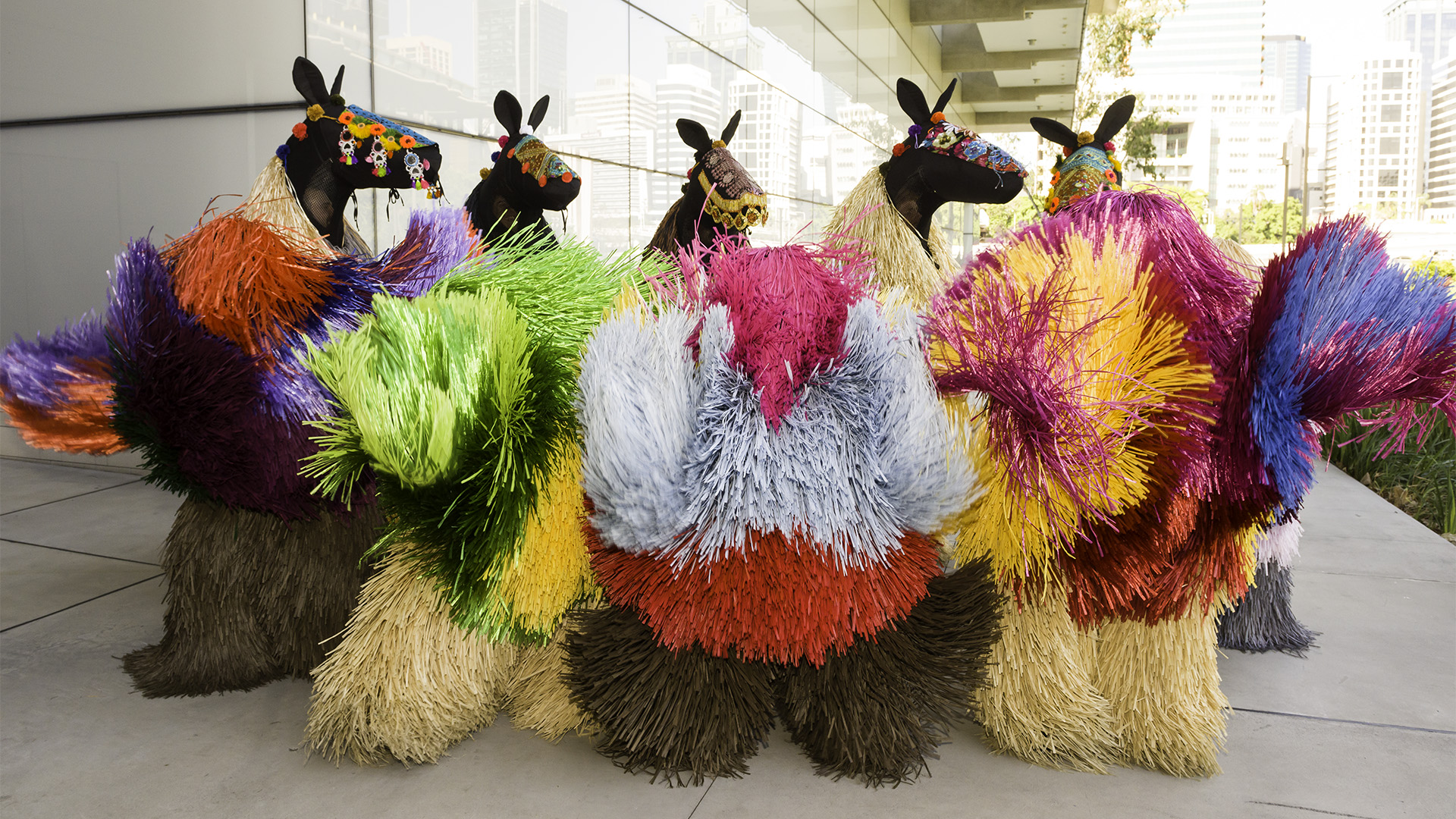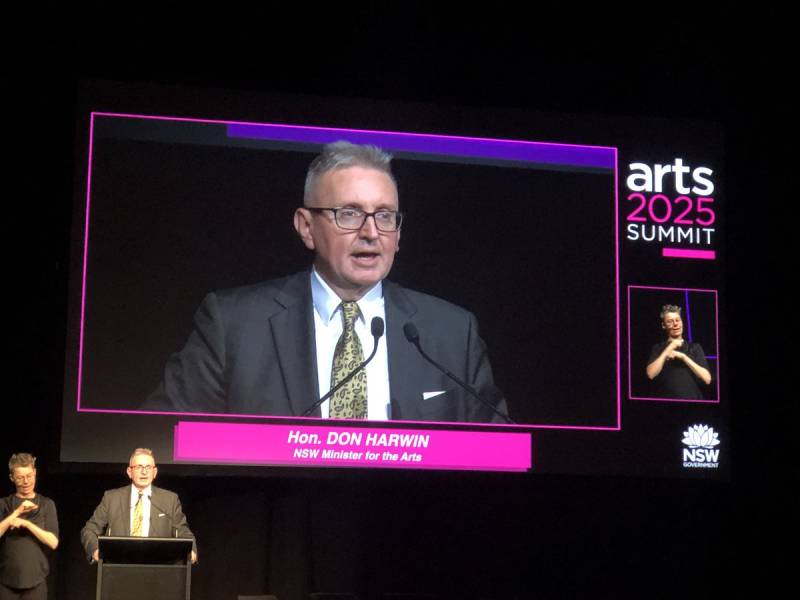The 2025 Summit and recurrent funding
By JUDITH WHITE
You’ve got to hand it to NSW Arts Minister Don Harwin – he’s stolen a march on the Labor Opposition in the run-up to the NSW State elections to be held in March next year.
Harwin, a Liberal Party numbers man and marginal electorate specialist, convened an Arts 2025 Summit held last Friday, 23 March, “to understand what your vision is for the future”. Sounds like a great idea.
Except that the talkfest summit was an invitation-only affair, with 500 handpicked guests. The agenda was strictly scripted too. It began with a video link to Premier Gladys Berejiklian, followed by a self-congratulatory speech from Harwin himself (pictured above) and then a series of slick presentations. There were no known critics of government policy invited to speak, and it seemed a little like a pre-election arts rally of the kind the ALP used to be proud to stage.
Fair enough, it seems that some interesting ideas and important issues were canvassed. Artist Justene Williams said she had to move out of NSW because it she couldn’t afford to live in the state and keep up her work. Sydney Festival director Wesley Enoch called for more coherent policies.
The keynote speaker was Ben Quilty, popular artist and trustee of the Art Gallery of NSW, which is the recipient of a promised $244 million in State funding towards its Sydney Modern building project. Quilty put forward the bright idea of giving artists the same tax breaks as athletes. Income tax is of course a Federal not a State issue, so who at the Summit would disagree? Quilty reportedly said that he couldn’t remember the arts having such an opportunity to speak to government, praised the Minister’s funding plans and appealed for the arts community to unite to promote the sector.
I’m all for unity – but on what platform? Support for the Coalition Government’s grandiose plans to dismantle the Powerhouse,move it to Parramatta and build Sydney Modern, with no serious alternative locations considered and no plans for ongoing funding, while only meagre sums are going to the regions? Funds have already been allocated, and regional cultural infrastructure gets a puny $25 million a year, for the whole state, compared to the $600 million being spent in central Sydney.

MCA chair Simon Mordant
A worthwhile contribution came from Simon Mordant, chair of the board at the Museum of Contemporary Art (MCA). He appealed for an extra $100 million in annual funds for the arts, saying: “If the state is more ambitious about the contribution the arts community is making, we need a greater level of core funding to realise those ambitions.” He pointed out what my book Culture Heist and this blog have been saying for a year, that with bigger institutions you need more recurrent funding, otherwise there will be real financial problems throughout the sector.
In fact $100 million barely covers it, when you think not only of the big metropolitan institutions but of the facilities needed for emerging artists and local communities. The State government spends far less on culture than other states – $18 per capita, compared to $31 in Victoria. And its “efficiency dividend” spending cuts are currently running at 2% per year. There’s a long way to go to redress the deficit on recurrent spending, let alone provide sustainable funding for new developments.
NSW Labor has yet to come up with any answers of its own. The party’s “Labor for the Arts” group, which promotes itself under the unrecognisable acronym L4TA, is big on motherhood statements – much like the Coalition.
Harwin: “Culture matters … Our stories, shaped by our profound diversity, are a vital expression of our identity, our experiences and our culture.” (Welcome to the Arts Summit)
L4TA: “NSW Labor recognises both the intrinsic and instrumental value of the arts, and will focus on strategic initiatives that increase arts access…” (Motion to State conference)
But Labor has so far taken no stand on the efficiency dividend, recurrent spending, the hugely unpopular Powerhouse move or the controversially-located Sydney Modern.
The vision of the Gorton and Whitlam years is nowhere to be seen.
Members out of the loop
Governments don’t much like independent voices in the cultural sector, and increasingly, sad to say, the institutions themselves seem to be following suit. The Art Gallery Society, the AGNSW’s membership body, was founded in 1953 as an independent body supporting the Gallery, and has had an unrivalled run of success in that capacity. Its Annual General Meeting was held last week, on 21 March.
The previous year’s AGM had heard that a new Memorandum of Understanding (MoU) had been signed with the Gallery, but members couldn’t be told what was in it – so we’re at a loss to know what the organisation’s function now is. Recently President Brian Ladd, formerly head of the Gallery’s Public Programs department, and executive director Ron Ramsey, signed a submission regarding the Sydney Modern Development Application (DA), fully supporting the project.
This year, for the first time in decades, the Annual Report was not circulated to members in advance of the AGM and was put on the Gallery’s website, without notification to members, only the day before the meeting. Until a few years ago the Society came under ASIC rules and had to circulate the report 21 days in advance. That tradition that was continued, in the interests of transparency, even after many regulatory functions were taken over by the Australian Charities and Not-for-profits Commission (ACNC), which does not have a similar requirement.
Following the President’s report to the AGM, members who asked why the report had not been circulated were told that the Society’s Council had taken legal advice that it was not required to do so. Well, it may be legal, but is it the best way to run a members’ organisation?
Meanwhile the mania for secrecy has been extended to the Gallery’s wonderfully loyal army of volunteers. Many were shocked when, in the past year, they were obliged to sign a confidentiality agreement, similar to that in force for staff, banning discussion of Gallery business with outside parties.
In recent months the Society has also disbanded the Task Force Fellows, a group for veteran volunteers no longer able to continue in their duties. Some have given their voluntary labour for decades. Their few ongoing benefits consisted of an occasional tour of a major exhibition and a modest annual Christmas gathering, which Edmund Capon, when Director, would happily attend. Before this past Christmas the Fellows received a letter, signed by executive director Ron Ramsey and volunteer coordinator Sue Dadswell, telling them that the group would no longer exist. The letter added: “Recent re-structuring in the Art Gallery Society means that staff can no longer offer the assistance as in the past,” and wishing them “all the best for the future”.
As one of the disillusioned Fellows put it to me, there is “a very different social atmosphere in the Gallery currently”.
NGV and GoMA in world’s Top 20
The Art Newspaper, the authoritative London-based guide to the art world, has just published its latest museum rankings for the past year, calculated on daily rather than total attendances. Up there in the Top 20 of the world’s most popular art exhibitions are the National Gallery of Victoria, at No.10 with Van Gogh and the Seasons (6,082 visitors daily, 462,262 in all); and at No.20, GoMA in Brisbane with the free exhibition Sugar Spin: You, Me, Art and Everything (4,729 daily, and a staggering 628,924 in total).
Visitor figures aren’t the only measure of success, but still, congratulations to Victoria and Queensland.
AGNSW didn’t make the Top 20.

Nick Cave’s “Heard” in “Sugar Spin” at GOMA





brilliant, as usual.
Great piece.
Often you must feel like a voice crying in the wilderness, but do keep on crying.
Your comments are spot on. Arts funding in this State, in the absence of a workable,
comprehensive policy, is increasingly misdirected, and in inverse proportion to the obscene
amounts directed to sports stadiums, roads and pointless consultancies.
It would be interesting to know who were the 500 arts people considered suitable to be invited to the Minister’s talkfest. I’ve yet to run into anyone who was there. Maybe they don’t want to admit it.
The News about the Art Gallery Society is profoundly dispiriting.